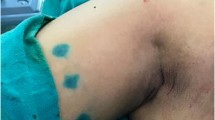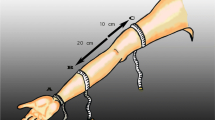Abstract
Background
The purpose of this manuscript is to assess the efficacy of direct lymphaticvenous microsurgery in the prevention of lymphedema following axillary dissection for breast cancer.
Methods
Nineteen patients with operable breast cancer requiring an axillary dissection underwent surgery, carrying out LVA between the blue lymphatics and an axillary vein branch simultaneously. The follow-up after 6 and 12 months from the operation included circumferential measurements in all cases and lymphangioscintigraphy only in 18 patients out of 19 cases.
Results
Blue nodes in relation to lymphatic arm drainage were identified in 18/19 patients. All blue nodes were resected and 2-4 main afferent lymphatics from the arm could be prepared and used for anastomoses. Lymphatic-venous anastomoses allowed to prevent lymphedema in all cases. Lymphangioscintigraphy demonstrated the patency of microvascular anastomoses.
Conclusions
Disruption of the blue nodes and closure of arm lymphatics can explain the significantly high risk of lymphedema after axillary dissection. LVA proved to be a safe procedure for patients in order to prevent arm lymphedema.



Similar content being viewed by others
Reference
Pain SJ, Purushotham AD. Lymphoedema following surgery for breast cancer. Br J Surg. 2000;87:1128–41.
Clodius L. More on axillary lymphadenectomy. Lymphology. 2003;36:1–6.
Roses DF, Brooks AD, Harris MN, Shapiro RL, Mitnick J. Complications of level I and II axillary dissection in the treatment of carcinoma of the breast. Ann Surg. 1999;230:194–201.
Pressman P. Surgical treatment and lymphedema. Cancer. 1998;83:2782–7.
Kissin MW, Querci della Rivere G, Easton D, Westbury G. Risk of lymphoedema following the treatment of breast cancer. Br J Surg. 1986;73:580–4.
Hardy JR. Lymphedema—prevention rather than cure. Ann Oncol. 1991;2:532–3.
Burstein HJ, Winer EP. Primary care for survivors of breast cancer. N Engl J Med. 2000;343:1086–94.
Hoe AL, Iven D, Boyle GT, Taylor I. Incidence of arm swelling following axillary clearance for breast cancer. Br J Surg. 1992;79:261–2.
Duff M, Hill AD, McGreal G, Walsh S, McDermott EW, O’Higgins NJ. Prospective evaluation of the morbidity of axillary clearance for breast cancer. Br J Surg. 2001;88:114–7.
Mortimer PS, Bates DO, Brassington HD, Stanton AWB, Strachan DP, Levick JR. The prevalence of arm oedema following treatment for breast cancer. Q J Med. 1996;89:377–80.
Lin PP, Allison DC, Wainstock J. Impact of axillary lymph node dissection on the therapy of breast cancer patients. J Clin Oncol. 1993;11:1536–44.
Olszewski WL. Axillary dissection for breast cancer. Lymphology. 2002;35:41–2.
Thompson M, Korourian S, Henry-Tillman R, et al. Axillary reverse mapping (ARM): a new concept to identify and enhance lymphatic preservation. Ann Surg Oncol. 2007;14:1890–5.
Nos C, Lesieur B, Clough KB, Lecuru F. Blue dye injection in the arm in order to conserve the lymphatic drainage of the arm in breast cancer patients requiring an axillary dissection. Ann Surg Oncol. 2007;14:2490–6.
Boneti C, Korourian S, Bland K, et al. Axillary reverse mapping: mapping and preserving arm lymphatics may be important in preventing lymphedema during sentinel lymph node biopsy. J Am Coll Surg. 2008;206:1038–42.
Klimberg VS. A new concept toward the prevention of lymphedema: axillary reverse mapping. J Surg Oncol. 2008;97:563–4.
Ponzone R, Mininanni P, Cassina E, Sismondi P. Axillary reverse mapping in breast cancer: can we spare what we find? Ann Surg Oncol. 2008;15:390–1.
Campisi C, Boccardo F. Microsurgical techniques for lymphedema treatment: derivative lymphatic-venous microsurgery. World J Surg. 2004;28:609–13.
Kleinhans E, Baumeister RG, Hahn D, Siuda S, Büll U, Moser E. Evaluation of transport kinetics in lymphoscintigraphy: follow-up study in patients with transplanted lymphatic vessels. Eur J Nucl Med. 1985;10:349–52.
Cambria RA, Gloviczki P, Naessens JM, Wahner HW. Noninvasive evaluation of the lymphatic system with lymphoscintigraphy: a prospective, semiquantitative analysis in 386 extremities. J Vasc Surg. 1993;18:773–82.
Schrenk P, Rieger R, Shamiyet A, et al. Morbilità following sentinel lymph node biopsy versus axillary lymph node dissection for patients with breast carcinoma. Cancer. 2000;88:608–14.
Sener SF, Winchester DJ, Martz CH, et al. Lymphedema after sentinel lymphadenectomy for breast carcinoma. Cancer. 2001;92:748–52.
Wilke LG, Mc Call LM, Posther KE, et al. Surgical complication associated with sentinel lymph node biopsy: result from a prospective international cooperative group trial. Ann Surg Oncol. 2006;13:491–500.
Bland K, Copeland E. The breast: comprehensive management of benign and malignant disorders. 3rd ed. St Louis, MO: Saunders; 2004.
Bourgeois P, Leduc O, Leduc A. Imaging techniques in the management and prevention of posttherapeutic upper limb edemas. Cancer. 1998;83:2805–13.
Pecking AP, Desprez-Curely JP, Cluzan RV. Tests and imaging of the lymphatic system. Rev Med Interne. 2002;23(Suppl 3):391s–7s.
Williams WH, Witte CL, Witte MH, McNeill GC. Radionuclide lymphangioscintigraphy in the evaluation of peripheral lymphedema. Clin Nucl Med. 2000;25:451–64.
Author information
Authors and Affiliations
Corresponding author
Rights and permissions
About this article
Cite this article
Boccardo, F., Casabona, F., De Cian, F. et al. Lymphedema Microsurgical Preventive Healing Approach: A New Technique for Primary Prevention of Arm Lymphedema After Mastectomy. Ann Surg Oncol 16, 703–708 (2009). https://doi.org/10.1245/s10434-008-0270-y
Received:
Revised:
Accepted:
Published:
Issue Date:
DOI: https://doi.org/10.1245/s10434-008-0270-y




